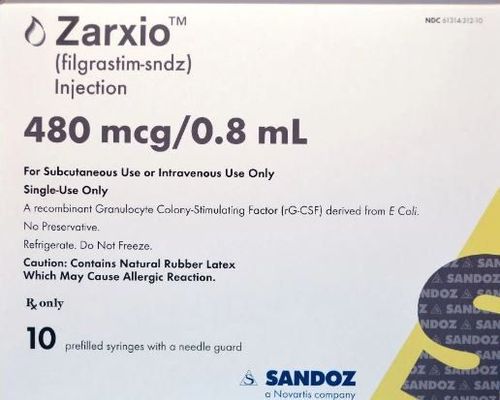This is an automatically translated article.
Plerixafor, also known as Mozobil. This is a medication that helps your bone marrow release stem cells into your bloodstream so they can be collected and transplanted back into your body. Mozobil Perixafor is used in people with non-Hodgkin lymphoma or multiple myeloma.
1. What is Plerixafor?
Plerixafor, also known as Mozobil. This is a medicine used to transport stem cells from the bone marrow into the bloodstream in some people with non-Hodgkin lymphoma or multiple myeloma.
Plerixafor is used in combination with granulocyte colony-stimulating factor (G-CSF) prior to autologous stem cell transplantation. G-CSF is given your first dose for 4 days to help your bone marrow make more stem cells and white blood cells. Your doctor will then prescribe Plerixafor to be taken daily for up to 4 days to make it easier for these stem cells to collect and can be transplanted back into your body.
Plerixafor is not a chemotherapy drug but is used in preparation for some autologous stem cell transplants.
2. How to use Plerixafor?
Plerixafor is injected under the skin. This medicine will be given about 11 hours before you are scheduled to have your blood drawn to collect cells before the transplant.
Before using Mozobil, you will be prescribed a medicine called granulocyte colony-stimulating factor (GRAN-yoo-loe-site) (G-CSF). G-CSF helps your body produce stem cells and white blood cells to support your immune system. Mozobil works together with G-CSF by causing stem cells and granulocytes made in the bone marrow to circulate into your bloodstream, where they can be collected in blood taken from your veins.
After your venous blood is drawn, the blood is processed so that the necessary stem cells and granulocytes can be separated from other unnecessary parts of the blood. These stem cells and granulocytes are then "implanted" back into your body.
Your blood test numbers will be monitored as you prepare for your autologous stem cell transplant. In it, the doctor will pay attention to your white blood cell count.
3. Undesirable effects of the drug Plerixafor
There are several things you can do to control the side effects of Plerixafor . Here are some of the most common or important side effects:
3.1. Diarrhea The treating doctor may prescribe the use of drugs in case of prolonged bowel movements. In addition, you can try changing your daily diet such as eating low-fiber foods, avoiding raw vegetables, drinking 8-10 glasses of water a day to prevent possible dehydration.
3.2. Severe nausea or vomiting Your doctor may prescribe medication to help control nausea and vomiting. In addition, daily dietary changes can be helpful. Avoid foods that can worsen symptoms, like heavy or greasy/fatty foods, spices or acids like lemons, tomatoes, oranges. You can replace it by gargling with salt water or drinking ginger tea to ease the symptoms.
During the infusion, if you feel dizzy or lightheaded, you should immediately contact the medical staff.
3.3. Injection site reactions Plerixafor may cause injection site reactions such as redness, swelling, pain, itching, numbness, rash or bruising at the injection site. If these symptoms do not improve after a few days, tell your treating doctor.
3.4. Headaches Your doctor may recommend or prescribe medications and other strategies to help relieve headaches while taking Plerixafor .
3.5. Less common side effects include: Allergic reactions: In some cases, you may have an allergic reaction to Plerixafor . Signs of a reaction may include difficulty breathing or breathing, chest pain, rash, flushing or itching, or a drop in blood pressure. Low Platelet Count (Thrombocytopenia): Platelets are what help your blood clot, so when your platelet count is low, you're at higher risk of bleeding. Some warning signs of thrombocytopenia include any bruising or excessive bleeding, including nosebleeds, bleeding gums, or blood in your urine or stools. If the platelet count becomes too low, you may be prescribed a platelet transfusion. Enlarged or ruptured spleen: Plerixafor can cause your spleen to swell or even rupture. Warning signs of this dangerous condition include new or worsening pain in your left upper abdomen (abdomen), or pain in your shoulder or shoulder blade.
4. Effects of Plerixafor on sexual problems
Exposure of the fetus to Plerixafor can cause birth defects, so women should not become pregnant while being treated with this medicine. Using birth control methods and having safe sex are necessary during treatment and for 1 week after your last dose. Even if your period stops, you can still be fertile, get pregnant, and conceive. You should not breast-feed during treatment with Plerixafor and for 1 week after the last dose. In short, the drug Plerixafor, also known as Mozobil. This is a drug that helps the bone marrow release stem cells into the bloodstream so they can be collected and transplanted back into the body. Mozobil Perixafor is used in people with non-Hodgkin lymphoma or multiple myeloma. To ensure the effectiveness of treatment and avoid unwanted side effects, patients need to strictly follow the instructions of the doctor, professional pharmacist.
Follow Vinmec International General Hospital website to get more health, nutrition and beauty information to protect the health of yourself and your loved ones in your family.
Please dial HOTLINE for more information or register for an appointment HERE. Download MyVinmec app to make appointments faster and to manage your bookings easily.













